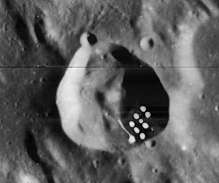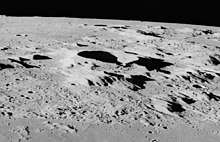Ukert (crater)
Ukert is a lunar impact crater that lies on a strip of rugged ground between Mare Vaporum to the north and Sinus Medii in the south. It was named after German historian Friedrich August Ukert.[1] It is located to the north-northwest of the crater Triesnecker and northeast of the crater pair of Pallas and Murchison.
 Mosaic of Lunar Orbiter 4 images (white spots are blemishes on original image) | |
| Coordinates | 7.8°N 1.4°E |
|---|---|
| Diameter | 23 km |
| Depth | 2.9 km |
| Colongitude | 359° at sunrise |
| Eponym | Friedrich A. Ukert |



The outer rim of this crater is not quite circular, with outward bulges to the north and the east. The interior floor is irregular in places, with a central ridge running from crater midpoint down to the southern wall. There is a tiny craterlet along the northern rim, but otherwise the crater contains no impacts of note.
Satellite craters
By convention these features are identified on lunar maps by placing the letter on the side of the crater midpoint that is closest to Ukert.
| Ukert | Latitude | Longitude | Diameter |
|---|---|---|---|
| A | 8.7° N | 1.3° E | 9 km |
| B | 8.3° N | 1.3° E | 21 km |
| E | 9.0° N | 0.4° E | 5 km |
| J | 11.1° N | 0.6° W | 3 km |
| K | 6.5° N | 3.7° E | 4 km |
| M | 7.9° N | 2.3° E | 26 km |
| N | 7.6° N | 2.0° E | 17 km |
| P | 7.8° N | 2.9° E | 5 km |
| R | 8.2° N | 0.7° E | 18 km |
| V | 8.7° N | 3.2° E | 3 km |
| W | 9.5° N | 2.3° E | 3 km |
| X | 9.2° N | 1.9° E | 3 km |
| Y | 10.1° N | 0.2° E | 4 km |
References
- "Ukert (crater)". Gazetteer of Planetary Nomenclature. USGS Astrogeology Research Program.
- Andersson, L. E.; Whitaker, E. A. (1982). NASA Catalogue of Lunar Nomenclature. NASA RP-1097.CS1 maint: ref=harv (link)
- Bussey, B.; Spudis, P. (2004). The Clementine Atlas of the Moon. New York: Cambridge University Press. ISBN 978-0-521-81528-4.CS1 maint: ref=harv (link)
- Cocks, Elijah E.; Cocks, Josiah C. (1995). Who's Who on the Moon: A Biographical Dictionary of Lunar Nomenclature. Tudor Publishers. ISBN 978-0-936389-27-1.CS1 maint: ref=harv (link)
- McDowell, Jonathan (July 15, 2007). "Lunar Nomenclature". Jonathan's Space Report. Retrieved 2007-10-24.CS1 maint: ref=harv (link)
- Menzel, D. H.; Minnaert, M.; Levin, B.; Dollfus, A.; Bell, B. (1971). "Report on Lunar Nomenclature by the Working Group of Commission 17 of the IAU". Space Science Reviews. 12 (2): 136–186. Bibcode:1971SSRv...12..136M. doi:10.1007/BF00171763.CS1 maint: ref=harv (link)
- Moore, Patrick (2001). On the Moon. Sterling Publishing Co. ISBN 978-0-304-35469-6.CS1 maint: ref=harv (link)
- Price, Fred W. (1988). The Moon Observer's Handbook. Cambridge University Press. ISBN 978-0-521-33500-3.CS1 maint: ref=harv (link)
- Rükl, Antonín (1990). Atlas of the Moon. Kalmbach Books. ISBN 978-0-913135-17-4.CS1 maint: ref=harv (link)
- Webb, Rev. T. W. (1962). Celestial Objects for Common Telescopes (6th revised ed.). Dover. ISBN 978-0-486-20917-3.CS1 maint: ref=harv (link)
- Whitaker, Ewen A. (1999). Mapping and Naming the Moon. Cambridge University Press. ISBN 978-0-521-62248-6.CS1 maint: ref=harv (link)
- Wlasuk, Peter T. (2000). Observing the Moon. Springer. ISBN 978-1-85233-193-1.CS1 maint: ref=harv (link)
External links
| Wikimedia Commons has media related to Ukert (crater). |
- Ukert at The Moon Wiki
- Nemiroff, Robert; Bonnell, Jerry (December 10, 2016). "The Lunar X". Astronomy Photo of the Day (APOD). - includes Lunar V